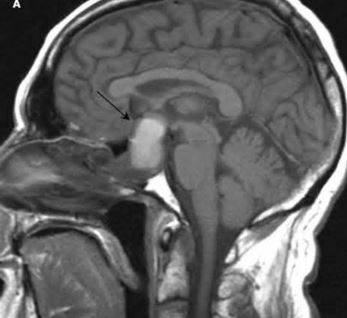Pituitary Apoplexy
What is pituitary apoplexy?
Apoplexy is the syndrome associated with larger bleeding and provides sudden onset of symptoms. Pituitary apoplexy is a medical condition occurs due to haemorrhagic or non haemorrhagic tissue damage in the pituitary gland.

It is found that most of the cases (60-90%), advancement of the pituitary macroadenoma is turned to pituitary apoplexy. But in a few cases, healthy pituitary gland can also develop pituitary apoplexy. In rare cases, a brain stroke or tumor formation in the pituitary gland causes the development of the pituitary apoplexy.
Usually there is a chance of development of the pituitary apoplexy with pituitary adenomas, specifically in case of macroadenomas (larger tumours).
In pituitary apoplexy, clinically expected that the sudden increment of the tumour size, which is responsible for compression to the pituitary gland, optic nerves and associated neurological structures which regulate eye movement. Blood vessel compression often leads to obstructed blood supply and tissue necrosis, haemorrhage and inflammation in the tumour.
Symptoms of pituitary apoplexy
The symptoms are not restricted in one organ; it provides various symptoms associated with different organs
Loss of peripheral visual power
Initially the symptoms include headache and nausea. If the haemorrhagic condition involves cerebro-spinal space, where it filled up with CSF (cerebrospinal fluid), then the intensity of the headache is severe with stiffness in the neck and body temperature increased than the normal.
Impaired Visual Power
- Optic nerve compression causes sudden visual impairment or worsening the vision.
- Peripheral or complete loss visual power
- Double vision occurs due to compression of the nerve which regulate eye movement
Hypopitutarism
Hormonal insufficiency occurs due to compression of the pituitary gland. Depending upon which hormone secretion are decreased according symptoms is arises:
Decrease secretion of the sex hormones including follicle-stimulating hormone and luteinizing hormone, the following symptoms are common
- Decrease sexual drive or lack of libido due to decrease levels of testosterone in male subjects. Hair growth in the body or facial region is also decreased.
- Infertility in women
Elevation of prolactin level in the blood often associated with large sized pituitary tumour. This effect is termed as “stalk effect”, as large sized tumour constrains pituitary stalks.
- This condition leads to decrease bleeding or irregular menstrual cycle and under production of breast milk in female.
Other clinical conditions associated with severe hypopituitarism are hypothyroidism or decrease cortisol levels. This may lead to fatal condition and following symptoms are common with hypopituitarism
- Anorexia
- Loss of weight or increased weight
- Lethargy
- Low energy level
- Reduction of the mental functioning
- Vertigo
- Drowsiness
Hypopitutarism also leads to electrolyte imbalance, specifically decrease sodium level in the blood and provides following symptoms like
- Tiredness
- Convulsion
Diagnosis
Initial diagnosis is started with symptom discussion and physical examination. Depending upon the symptoms, blood tests are conducted for checking the following hormonal level:
- Adrenal corticosteroid stimulating hormone
- Cortisol
- Follicle stimulating hormone (FSH)
- Growth hormone
- Luteinizing hormone (LH)
- Thyroid stimulating hormone (TSH)
- Prolactine
- IGF -1
Other than these blood tests, following confirmatory tests are also conducted:
MRI
For obtaining good images of the tumor, the UCLA Pituitary Tumor Program is used in the MRI pituitary protocol. This can able to get the size of the bleed.
CT scans of the pituitary helps to detect any abnormalities present in the pituitary gland.
Eye Examination
If visual impairment occurs, then eye specialist examines the visual power. This evaluation includes eye sharpness and peripheral vision.
Treatment
If diagnosis confirming the presence of pituitary apoplexy, then following treatment options are available
- Treatment for fluid and electrolyte imbalance
- Corticosteroid administration, as the deficiency of corticosteroid leads to life threatening condition.
- Transsphenoidal surgery in the case of vision impairment
- Hormonal replacement therapy for thyroid hormone, growth hormone and sex hormone included estrogens for female and testosterone for male.
These treatments lessen the mortality rate.
Prognosis
The surgical intervention is beneficial for visual improvement. In maximum cases, hormonal replacement therapy can continue for whole life, as patients are suffering from permanent hormonal deficiencies.
References
- http://radiopaedia.org/articles/pituitary-apoplexy
- http://www.ajnr.org/content/23/7/1240.full
- http://pituitary.ucla.edu/body.cfm?id=48
- https://www.nlm.nih.gov/medlineplus/ency/article/001167.htm
- http://emedicine.medscape.com/article/1198279-overview
